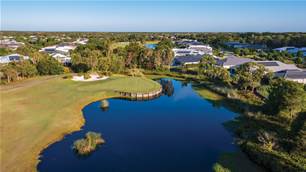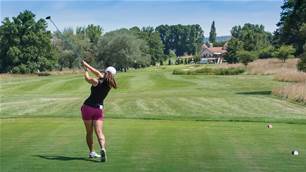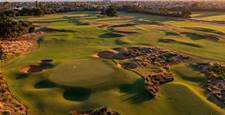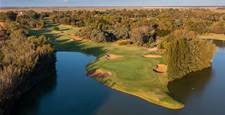The drive north-east from the Perth CBD through to the Swan Valley is one of the nicest journeys you can make in and around the West Australian capital.
Established vineyards come and go the deeper you get into the valley, where you will find The Vines Resort & Country Club, a former tournament venue where the kangaroos are plentiful, and the landscape is dominated by massive greens and rolling fairways.
It was here during the 1990s that the European Tour made its home for one week a year, co-sanctioning the Heineken Classic and, later, several Johnnie Walker Classics with the Australasian PGA Tour. Both events offered the biggest prize purses in Australian golf and, as a result, attracted superstars in the men’s game including Greg Norman, Ernie Els, Fred Couples, John Daly, Bernhard Langer and a host of others.
Some of the biggest names in women’s golf also played at The Vines in the 2007 Lexus Cup, a team event inspired by the Solheim Cup where the best players from Asia, like major winners Se Ri Pak and Jiyai Shin, were pitted against the finest Internationals including the legendary Annika Sörenstam as well as the likes of Cristie Kerr, Morgan Pressel and Natalie Gulbis.
The pros in all these events played a composite course with the best holes drawn from the Graham Marsh and Ross Watson-designed Lakes and Ellenbrook courses. In fact, even today, more than two decades after the Heineken Classic moved from The Vines to Royal Melbourne Golf Club, the composite course – incorporating holes 1, 2 and 12 through 18 of the Ellenbrook layout, with the Lakes layout back nine – is often referred to as the ‘Heineken’ course.
The Vines recently announced a masterplan for the entire property to undergo a $9 million upgrade that will ultimately see the composite course brought back into play as the resort’s tournament layout, with a nine-hole short course and a two-tiered driving range to be built. Other areas of what is now much of the front nine of the Ellenbrook course will become part of a residential development.

The first stage of upgrading the composite course has begun with new irrigation and drainage work being carried out, as well as some bunker remodelling.
The best holes across the entire property will remain. Opening a round will be the 1st hole of what is now the Ellenbrook course, which is a great entrée.
At 379 metres, this par-4 calls for distance and precision from the tee. Your drive should skirt the edge of the large fairway bunker (about 210 metres off the tee) to the left to leave an easier short- or mid-iron to the slightly elevated, tiered green.

When ‘Wild Thing’ Daly visited The Vines to play the 1996 Heineken Classic - and run T5, his best ever finish in Australia - he used a 3-iron from the tee every day. Indeed such was his respect for the whole course “it was the first time I ever played 72 holes without using my driver,” he said.
The tournament course will boast a fine collection of par-3s, with the current Ellenbrook 13th (which will become the 4th hole) and the Lakes’ 16th the best of the lot. While bunkering dominates on the 13th, there is water and sand at the long 16th.
Like so many of the holes at The Vines, the pin position really dictates how the hole should be played. When the flag is on the left of the green – which sits diagonally to the tee – it is a straight-forward mid- to long-iron with the water and bunkers to the right only coming into play for bad mishits. But when the flag is positioned right your tee shot must carry 200 metres with the water and sand most definitely in play. In fact, the smart play in this situation is to aim for the centre of the green and watch the ball take the break off the sloping putting surface and finish near the flag.

Throughout the past 100 years, some of the game’s best-credentialed golf course designers have been lured to Perth on the promise they would find land north of the Swan River that is worthy of creating a memorable layout.
The first to do so was Alex Russell, the 1924 Australian Open champion and design associate of Dr Alister MacKenzie in Australia, who set the tone for what was to follow with his creation for the Lake Karrinyup Country Club.
Today, a 20-minute drive north of the CBD can have you standing on the 1st tee at one of four impressive layouts that have all been ranked in the nation’s Top-100 Courses by this magazine.
Lake Karrinyup remains the best of them – a past Australian Open venue and a host of other big events including the WA Open, Perth International, Johnnie Walker Classic and World Super 6s.
Ranked No.22 in Australia, Lake Karrinyup has undergone two major renovations in the past 15 years, both of which have been inspired by Russell’s original design and have really improved the golfing experience.

Mike Clayton oversaw the first 18-hole renovation which was completed in 2006. It was an extensive redesign that embraced Russell’s vision and was widely acclaimed. A little over a decade later, Mike Cocking – of the design firm (Geoff) Ogilvy, Cocking and (Ashley) Mead (OCM) – supervised recontouring and bunkering shaping as all 18 greens were converted to the impressively smooth 007 bentgrass.
Karrinyup, which will celebrate its centenary in 2028, features multiple blind tee shots and elevation changes that make driving the ball a test of trust that you have selected the right line. And like so many of the great courses presents a risk and reward style, with fairways offering width but requiring the correct line if you are to receive a bounding run down to the hole and the best line to attack the green.
The imposing trees throughout the property and the par-72’s rugged bunkering – which appears to have been shaped by nature rather than man – make Karrinyup a visually stunning course.

Lake Karrinyup isn’t the only course in the suburbs north of the Swan that has undergone, or is undergoing, extensive renovations.
OCM is currently overseeing the greens replacement program and bunker remodelling at Mt Lawley Golf Club, which, like Lake Karrinyup, was formed in 1928.
The club recently entered Stage Two of the wholesale changes, including a rebuild of the 2nd, 3rd, 5th, 6th, 12th, 13th, 14th and 16th greens and their surrounds, which is due for completion in 2024.
Easily the most intriguing of these changes is the restoration of the short downhill par-3 13th ‘Commonwealth’ hole – with the green to more closely resemble the map of Australia, including Tasmania, with bunkers added to highlight the unique shape of the putting surface.
Mt Lawley covers beautiful terrain that doesn’t appear far removed from the great landscape which is home to Melbourne’s world famous Sandbelt courses. One of the finest attributes of those courses is the close-cut relationship between greenside bunkers and the putting surface. This is certainly a feature of the OCM redesign.
Mt Lawley’s nearest golfing neighbour The Western Australian Golf Club – little more than five minutes’ drive away in Yokine – has undertaken some renovations of its own in recent years.
Course superintendent Idris Evans, who has been at The Western Australian for more than three decades, has overseen turf upgrades and some bunker remodelling which has continued to raise the standard of the highly acclaimed course. The layout is immaculate, with some of the finest bentgrass greens and beautifully manicured surrounds to be found in the state.

The layout opens unusually with a spectacular, daunting long par-3. Stretched to 210 metres from the tips, the 1st hole has water flanking the entire left side of the fairway, and tall eucalyptus trees and out-of-bounds to the right. Two bunkers short, left of the green and another front right offer additional protection to par. The huge putting surface is quite receptive and features only subtle undulations, but generally most putts break towards the front of the green.
As you walk to the opening green, take a glance over your left shoulder at the hole bordering the other side of the lake. For many, the 9th hole is Western Australian’s most memorable par-3. At 176 metres, it’s a beautiful one-shotter that plays across the edge of a lake to the green with the historic Tudor-style clubhouse in the background. The angled putting surface is deep and narrow with two deep bunkers left, another back right and a smaller pot-style bunker short right.
The 288-metre par-4 12th has earned a reputation for offering the best city view from any Perth golf course. The sweeping vista from the 12th tee is a good one, but so is the hole that lies out in front. The short downhiller tempts players to take on the huge bunkers short of the angled green. The reward for avoiding the sandy hazard short left of the putting surface, will be a chip or putt for eagle. But there is the risk of finding the sand, leaving an awkward and difficult bunker shot resulting in a bogey or worse.
Nearly 25 minutes’ drive west across the northern suburbs is Cottesloe Golf Club, which has just entered the final stage of a Graham Marsh redesign masterplan that was first set out in 1998.
Work has begun on the final six holes of the restoration – from the 11th through to the 16th – which will see bunkers remodelled as well as green complexes rebuilt and resurfaced with 777 bentgrass. Cottesloe will be the first Australian course to have this new super bentgrass on all its holes, and it will be the first time in more than four decades that all 18 greens of the layout will be covered in the same grass.
Marsh’s renovation has enhanced the natural landscape of the property, with its significant changes in elevation, mature trees and rolling fairways.
Cottesloe requires strategic play from the tee to avoid numerous fairway bunkers and set up straightforward approaches into the often dramatically undulating putting surfaces. A big part of Marsh’s design theory here has been to counter the course’s lack of modern course length with complex greens full of slopes and tiers demanding an approach shot from one side of the fairway or the other, depending on the pin position of the day.
One of Cottesloe’s most memorable offerings is the 416-metre par-4 12th hole where three bunkers – one left and two right – line the driving zone. Another two bunkers, which will be reshaped as part of the Marsh upgrade, lie left of the pear-shaped green, which is most receptive to approach shots from the right third of the fairway.
The final stage of the restoration is due to be completed in March 2024.
Cottesloe Golf Club originally occupied coastal land about five minutes’ drive to the south, which is where, today, you will find Sea View Golf Club, regarded as one of the best nine-hole courses in the country.
Golf was first played on this land back in 1908 making it the third oldest course in Western Australia. Former British Amateur Champion Peter Anderson, who was then Perth’s Scotch College headmaster, laid out the original nine holes on natural undulating terrain opposite the beach.
Sea View not only offers alternate tees for a second nine, but also boasts alternate flags on the 1st/10th, 5th/14th, 7th/16th and 8th/17th, such is the size of the putting surfaces on these holes.
Just as Cottesloe Golf Club was settling into its new home in the early 1930s, a lease was being granted to a private company, Wembley Downs Public Golf Course Ltd, for 150 acres at nearby Floreat Park.
Under the direction of engineer turned course designer, Walter Fox, trees and scrub were cleared – much of it by hand – from across the rolling topography to the east of where the clubhouse now offers views of the property.
The then Perth City Council took over the course in 1943 and in the years after World War II set about improving the original layout and, during the 1950s, a further nine holes were added. The remaining nine holes to complete a 36-hole complex opened for play in 1983 and the ‘new’ 18 was later named the Tuart Course.
Perth rezoning led to the Town of Cambridge Council taking over the complex in 1995. The serious investment and planning to transform Wembley into the world-class public golf facility that greets today began in 2010 and was completed within six years.

Today, the Wembley Golf Complex hosts more than 175,000 rounds per annum, while 21 million balls will be hit on the two-tiered driving range, making it the most popular public golf complex in the country.
Fox’s original Old Course has easily withstood the test of time as his routing remains as it was nearly 90 years ago. By modern standards it’s not a long course at 5,793 metres from the back markers, but there are some serious challenges during a round.
While this layout was Fox’s only foray into golf course architecture, he obviously had an eye for what makes for interesting and testing golf.
Routed across rolling terrain, there are only a few straight holes weaving between this most heavily wooded area of the property. Huge stands of tuart, banksia and gum trees line each hole and are the obvious hazard as you stand on each tee.

The most memorable sequence of holes at Wembley is on the back nine of the Tuart Course and starts with the nerve-rattling short par-4 14th and concludes with the diminutive par-3 18th.
The 14th is a tight two-shotter of 318 metres off the back tees. The strip of fairway veers slightly left and opens up to reveal a narrow, deep green cut up to the edge of a lake to the left and a lone bunker to the right.
At 472 metres, the par-5 15th is the longest of all the holes at Wembley, although it plays much shorter than the scorecard number as the journey is all downhill from tee to green. The extra distance on your drive here will tempt many to try and hit the green in two blows. But it is a tough shot from a lie where the ball is likely to be slightly below your feet (for right-handers), encouraging a left-to-right ball flight, and the slope of the green and its surrounds is down to the right and a deep greenside bunker. Try and fight the hanging lie and leave your shot left of the flag, and you will be faced with a testing downhill chip or putt.
Tuart’s closing hole is the shortest of all the par-3s at Wembley and it is also the newest hole, having been built and brought into play during the construction of a holding dam a decade ago. The 125-metre hole calls for a tee shot to be played across the edge of the dam to a large two-tiered putting surface, guarded by a wasteland bunker right and a small trap cut into the front right edge of the green. It is a deceptive tee shot as the hole plays slightly uphill, which brings the sand into play for those who choose the wrong club.
Changes are coming for Wembley with course architects Harley Kruse, of KruseGolf, and Mike Clayton, of Clayton, Devries & Pont (CDP), commissioned to create some redevelopment concepts.

Any future redevelopment work could include course redesigns, a short course, a par-3 course, new putting layouts and a state-of-the-art, floodlit short-game practice and teaching area.
“For one thing, there’s potential to enhance both of our existing 18-hole layouts. The Old Course has remained unchanged since its opening in 1932, with no significant changes to the newer Tuart Course for more than 30 years,” Wembley General Manager Josh Madden said.
While Wembley has become the torch bearer for successful council-managed public golf complexes, Perth is lucky enough to have several other courses across the northern suburbs that offer affordable, good quality golf.
Marangaroo Golf Course can be found about 25 minutes’ drive north of the CBD right in the heart of suburbia. But you would never know it during your round, as you trek along holes laid out through a beautiful bushland setting complete with hordes of kangaroos.
Opened in 1988, the Murray Dawson-designed layout has since evolved into one of the busiest public access courses in Perth.

Its popularity can be attributed to Dawson’s interesting design – incorporating many doglegs and some blind tee shots – very good conditioning and the wonderful setting.
Dawson’s brief was to create an interesting layout that would appeal to players of all standards. There is enough of a challenge for the better player here, while the casual golfer or beginner should not be too intimidated by the layout, which is relatively short at 5,617 metres from the back markers.
There are very few bunkers on the course, with the first appearing to the left of the green on the par-3 6th hole. There is another at the next, and it plays a pivotal role in how you attack the hole.

The 275-metre 7th is a terrific slight dogleg left short par-4 where those wishing to have a crack to reach the green with their driver will need to skirt a small lake on the left edge of the fairway, while also trying to avoid a lone bunker short and right of the green. There are probably more bogeys than birdies here but taking the risk is worth the fun of it all.
The City of Wanneroo was behind the creation of Marangaroo and six years after it opened, the council was signing off on another course development just 20 minutes’ drive north.
Carramar Golf Course opened for play in 1994 and today, off the back markers, is widely regarded as one of the toughest tests of golf in Perth.
Designed by Bob Stanton, Carramar stretches to 6,121 metres from the back pegs and covers gently undulating terrain. Many of the holes are densely tree-lined doglegs, left and right, which adds significantly to its stern test.
The most challenging hole is the 423-metre par-4 5th hole, known as ‘Heartbreak Hill’. Many a round has been ruined by this brute. A straight and long drive from the elevated tee is needed to reach the corner of the slight dogleg left and leave you the opportunity of hitting up the hill onto the green.

On the inward nine there is a similarly tough par-4 at the 17th. The 376-metre two-shotter is all uphill to a small green, which sits beyond some encroaching tall timbers and is also protected by bunkers short and long. It is a daunting prospect to have a long iron in your hand and be faced with an approach to such a small uphill target.
Carramar’s nearest neighbour is the Wanneroo Golf Club, just five minutes’ drive away.
The first fully reticulated golf course in Western Australia, Wanneroo offers outstanding playing surfaces, an enjoyable tree-lined layout and a peaceful setting.
Designed by Bob Green and Murray Dawson and opened for play in 1973, the par-72 places a premium on accuracy from the tee through its doglegging par-4s and 5s and stands of native trees, while the sloping surrounds and greenside bunkering are another real feature of the layout.
But it is the flawless condition of the couch fairways and bentgrass greens that make Wanneroo a standout and were undoubtedly a key factor in earning the club co-hosting honours alongside Lake Karrinyup for the 2018 Men’s and Women’s Australian Amateur Championships

Standing on the tees at Wanneroo, the visual contrast of the fairways, which feature only slight changes in elevation throughout the 18 holes, against the sandy base of the surrounding trees clearly identify your target. And once successfully on the short grass, golfers are greeted with evenly covered surfaces that are a pleasure to play from.
The greens feature breaks that are more subtle than severe and, although not excessively fast, run extremely true.
The best known and highest ranked public access course in this region of Perth is the
27-hole complex at Joondalup Resort, which recently hosted the 2023 WA Open.
Few courses anywhere in the world offer the dramatic contrasts, the scenic beauty and the sheer golfing challenge you will find at Joondalup. Designed by the internationally renowned course architect Robert Trent Jones Jnr., Joondalup is a tough, uncompromising layout, featuring great variation in setting and style as it sweeps across dense bushland, cuts through steep limestone quarries and skirts picturesque lakes.
By anyone’s measure, Jones created a great course at Joondalup. In fact, he created three courses, as the Quarry, Lake and Dune nines can be played in three different combinations.
Perhaps the most striking of all Joondalup’s holes can be found on the Quarry nine. When you stand on the 2nd tee – with the fairway falling and rising through a valley, past two massive bunkers including one that resembles a moon crater, to a green perched on a plateau more than 350 metres away – you can’t help but be excited about the golf that is to come.
If the 2nd doesn’t take your breath away, the 3rd hole will. This is a wonderful par-3 that has six tees of varying distances and angles to the green. From the back markers, it’s a 136-metre shot for what would normally be a smooth 6-, 7- or 8-iron into a ‘normal’ green. But this is no normal green. Your tee shot must carry the abandoned quarry gorge to find the green perched on the other side. A mishit short or right is into the gorge and out-of-bounds, and a heart breaking third shot from the tee.
If you are restricted to playing just 18 holes during your visit to Joondalup, try and organise to play the Quarry and Dunes course combination.
There are plenty of standout holes on the Dune and Lakes nine but the best are on the Dunes, particularly the 3rd and 4th holes that are laid out in a natural amphitheatre created by towering rock walls – one to the right of the 3rd fairway and the other to the right of the long par-3 4th hole.

Jones’ design aside, Joondalup’s greens, fairways and tees are always in great condition. But nothing has been left to task. The surrounds are also superb with the well-groomed gardens around the resort and clubhouse indicative of a five-star establishment.
Heading north from Joondalup, it’s an easy 30-minute drive to Yanchep and the Sun City Country Club, which first opened for play in July 1974 and was originally expected to be part of an adjoining housing development planned by high-profile businessman Alan Bond.
Designed by Bob Green in collaboration with the club’s first captain, Murray Dawson, the layout immediately proved popular after opening and hosted the Western Australian PGA Championship for three years from 1975 to 1977.
Sun City gained a reputation for the quality of its greens, characterised by their subtle breaks and superb surfaces, and the demand the layout placed on accuracy with doglegs, left and right, on most holes. However, after nearly four decades the original tree plantings had started to suffocate the course as they had grown large and encroached onto many of the ideal playing lines. This was particularly penal on shorter hitters, who were forced to take a longer route to the green on many holes.
A decade ago, the club benefitted from the sale of land and entered a joint venture with a developer, who planned to create a housing estate along the southern edge of the course. The club decided it was an ideal time to masterplan a redesign of the layout and the then design team of Geoff Ogilvy, Mike Clayton, Mike Cocking and Ashley Mead (OCCM) was commissioned.
The transformation of Sun City has been gradual but dramatic. The new green complexes are bigger and more interesting, as are the surrounds, while the natural bunkering and vast wasteland areas expose the sandy base that lies beneath.
Half of the course – three holes on the front nine, and the first six holes of the back nine – have been redesigned and offer most of the highlights of a round at Sun City. These holes were completed in 2016 and are easily distinguished from the untouched holes awaiting transformation.
With the redesign work being funded by the developers of the adjoining residential estate, the next phase of Sun City’s improvement is soon to begin and, when it does, the layout will surge in the national ranking again
WHERE TO PLAY
THE VINES RESORT
Green fee: Ellenbrook – $60 (18 holes, weekdays), $70 (weekends); Lakes – $85 (18 holes, weekdays), $90 (Sunday).
LAKE KARRINYUP CC
Green fee: Private club. Upon application.
MT LAWLEY GC
Green fee: Private club. Upon application.
THE WESTERN AUSTRALIAN GC
Green fee: Private club. Upon application.
COTTESLOE GC
Green fee: Private club. Upon application.
SEA VIEW GC
Green fee: $38 (18 holes, weekdays); $43 (weekend).
WEMBLEY GOLF COMPLEX
Green fee: $39 (18 holes, weekdays); $46 (weekend), when booked online.
MARANGAROO GOLF COURSE
Green fee: $35 (18 holes, weekdays); $40 (weekend).
CARRAMAR GOLF COURSE
Green fee: $35 (18 holes, weekdays); $40 (weekend).
WANNEROO GC
Green fee: $60 (18 holes, weekdays)
Related Articles

Travel Feature: Golf’s Sunny Side

Bekker embraces a potential new chapter in the West












